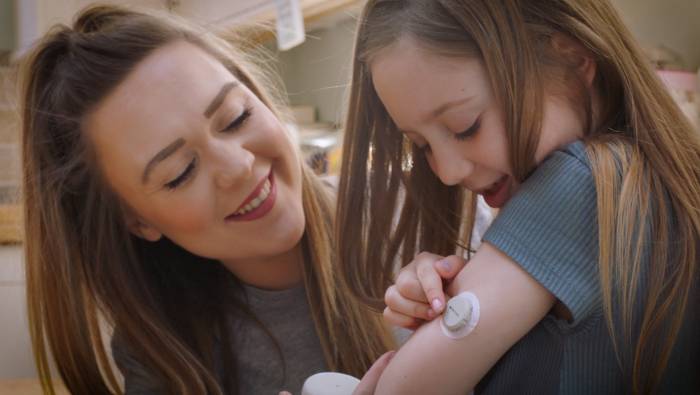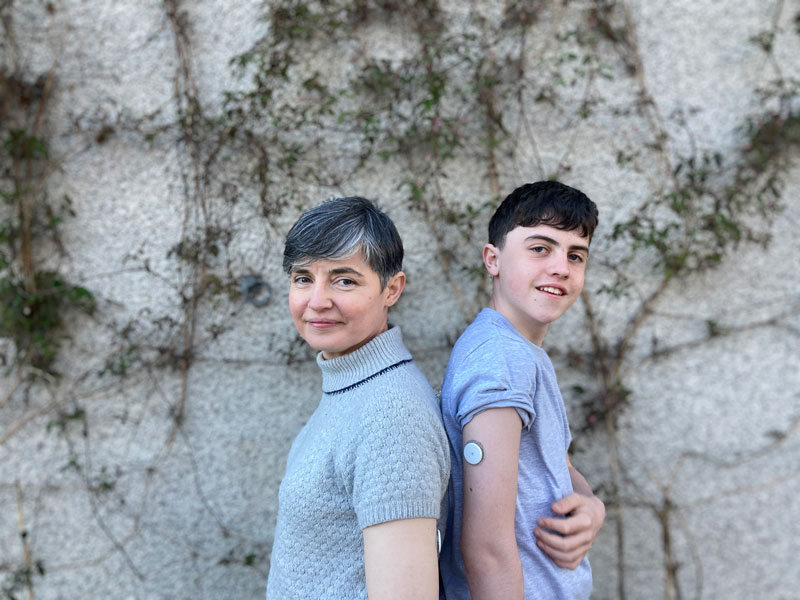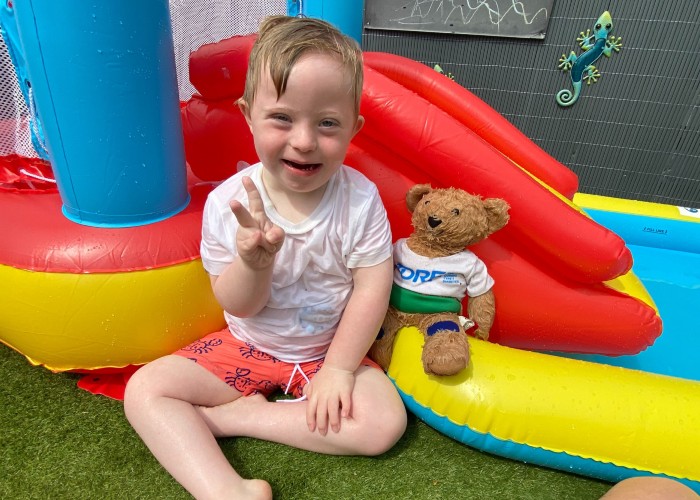Type 1 treatment and technology for children
Learn about the different types of tech for monitoring blood glucose levels and getting insulin into your child’s body. Find out how to access type 1 tech on the NHS and learn from others’ stories.
When your child is newly diagnosed they will usually use an insulin pen to inject insulin and a blood glucose meter, a continuous glucose monitor or flash sensor to monitor their glucose levels.
As you continue your journey with type 1, you may want to move on to other technologies that can make life with type 1 easier. Take things at your own pace and remember, you don’t have to learn everything about type 1 all at once.
Speak to your Diabetes Healthcare Team about moving on to different devices and technologies.
Insulin
Insulin is a hormone that helps our bodies convert glucose (sugar) into energy. It stops the amount of glucose in the blood going too high.
When someone has type 1, the beta cells in their pancreas no longer produce insulin. So they have to put it in their bodies themselves.
There are two main types of insulin – long-acting and fast-acting. Most newly diagnosed children use both of these to start with:
- Long-acting insulin is usually taken in the mornings and releases slowly over 24 hours. This is also known as called basal insulin
- Short-acting insulin is taken at mealtimes to manage blood sugar around carbohydrates. It is taken to bring down high glucose levels. It’s also known as bolus, mealtime or prandial insulin
Find out more about insulin.
Insulin pen injections
There are two main types of insulin pens; reusable pens, where you replace a cartridge in the pen when the insulin runs out, or pre-filled disposable pens, where you simply use a whole a new pen when the old one runs out.
Children and adolescents will use a 4mm pen needle regardless of age, gender or body mass index (BMI).
Find out more about using pens to inject insulin.
Smart insulin pens

Smart insulin pens are the same as regular insulin pens except that they connect to an app. This allows you to record how much insulin your child has taken and when.
Smart insulin pens are available on prescription in England, Wales, Scotland and Northern Ireland. You just need to ask your Diabetes Healthcare Team for a prescription which can be put onto a repeat prescription by your GP.
Find out more about smart insulin pens.
Blood glucose meters
A blood glucose meter is a small device that checks the amount of glucose in the blood.
There are three components to a blood glucose meter – the meter itself, blood test strips, and a lancet to prick your child’s finger.
Your child will have been given a blood glucose meter when they were diagnosed.
Find out more about how to use them and how to get the most accurate readings.
Continuous glucose monitoring
A continuous glucose monitor, or CGM, is a small wearable device that measures glucose levels in real-time.
It uses a sensor and transmitter to continuously send information about your child’s glucose levels to a handset or compatible mobile phone. On some CGMs, you can also access this data on a cloud-based platform, allowing you to check your child’s glucose levels even when you’re not with them. You can also share this data with your Diabetes Healthcare Team, teachers and carers.
A CGM shows you:
- your child’s current glucose levels
- a trend arrow that shows whether their glucose is heading up, down or is stable
- alerts and alarms which signal when their glucose has gone too high or too low
- graphs to help you see where things are going well and work out where things could be better
Find out more about continuous glucose monitoring.
Find out how to get CGM on the NHS.
Flash glucose monitoring
A flash glucose monitor, also known by its brand name Freestyle Libre, is a device that your child can wear to measure their glucose levels. You can review your child’s glucose data on a cloud-based platform on your mobile phone or computer, so you can check their glucose levels even when you’re not with them.
To use flash, you attach a sensor to the upper part of your child’s arm, then you scan or ‘flash’ the sensor with a handset or compatible mobile phone to get a reading.
The reading gives you:
- your child’s current glucose level
- a graph of your child’s glucose level over the last eight hours
- a trend arrow to show if your child’s blood glucose is rising, stable or falling
Find out more about flash glucose monitoring.
Find out how to get flash on the NHS.
Insulin pumps
An insulin pump is a small wearable device that delivers short-acting insulin every few minutes in tiny amounts, 24 hours a day.
At the touch of a button it also delivers extra short-acting insulin when your child eats or needs to bring down high blood glucose levels.
There are two kinds of insulin pumps; patch or micro pumps, which stick directly onto the skin, and tethered pumps, which attach through a cannula or tube.
One of the advantages of using an insulin pump with young children is that they can give more precise doses that smaller bodies sometimes need.
However, different types of insulin pumps are designed to be used for children of different ages. Some are for children aged two and up, some are for older children.
Find out more about how insulin pumps work, the different types, and the pros and cons of using one.
Find out how to get an insulin pump on the NHS.
Hybrid closed loop technology
A hybrid closed loop (HCL) system, also known as the artificial pancreas, takes readings from a continuous glucose monitor and uses an algorithm to tell a pump how much insulin to deliver. It does this 24 hours a day.
HCL automates many of the decisions that you need to make every day when managing a child’s type 1. It’s called ‘hybrid’ because you still have to count carbohydrates and be aware of how quickly carbs will reach your child’s bloodstream and give it blousing information before they eat.
Find out more about how hybrid closed loop technology works.
Find out if hybrid closed loop technology is available on the NHS.
What treatment and technology is available on the NHS?
Insulin, insulin pens and blood glucose meters are given to everyone who is newly diagnosed with type 1. Smart insulin pens are available on prescription in all four nations of the UK. Ask your GP for a prescription.
Find out how to access flash, CGM, insulin pumps and hybrid closed loop technology.
Explore type 1 tech options
We know that deciding whether to use type 1 technology and then choosing the right devices and apps can be a bit daunting. Find out what’s available for your child in your area with our tech finder tool.


Upcoming Type 1 Diabetes Discovery Events
Join us for virtual and in-person information events dedicated to exploring the world of type 1 diabetes. Discover the latest developments in type 1 research, hear from experts in the field and connect with others living with type 1.
Discover more articles, videos and stories
Our resource hub is home to a wealth of information and shared experiences about living with type 1 diabetes.










